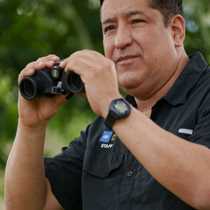In this beautiful day we woke up with the magnificent view of Sombrero Chino and the Bainbridge Islets. These beautiful parasitic cones of Santiago Island were probably formed a long time ago when the sea level was lower. Sombrero Chino can be roughly translated to English as “Chinese Hat”. It has an extended peculiar shape that resembles a huge hat like the ones worn in some regions of China. This unusual yet striking shape is typically found in oceanic islands of volcanic origin. These kinds of formations are also known as “shield volcanoes”.
After breakfast we explored the area using our loyal Zodiac fleet. The Zodiac ride was a very successful one for we had the chance to cover a long distance admiring the striking volcanic landscape and looking for wildlife. Galapagos penguins, several heron species, marine iguanas and sea lions were admired and photographed.
Once on board we put on our snorkeling gear to continue exploring the area but this time by doing deep-water snorkeling. The underwater world in this exotic location was as its bests today for it was sunny and the waters were crystal clear. We had great sightings like some Galapagos penguins swimming swiftly, sea lions fishing, and several white tip reef sharks among many colorful species of tropical fish.
At the end of the snorkeling session we enjoyed the cool ocean in a very different fashion: jumping from the National Geographic Islander! It was a lot of fun not only for the eighteen kids we have aboard this week but for all who participated in this amusing activity.
At lunch time, the ship was repositioned to the south of the fourth largest islands of the Galapagos archipelago, Santiago Island. On our way to Santiago Island we sailed near Bainbridge Rocks and from a distance spotted some Greater flamingos on an inner salty water lake inside the crater.
In the early afternoon our eager younger explorers had a blast while learning how to drive our Zodiacs. Next, I had the joy of giving a talk about Charles Darwin, one of my favorite topics, with a presentation entitled “Charles Darwin, a retrospective of his life”.
In the late afternoon we disembarked at Sullivan Bay for an unforgettable hike on fairly recent lava flow. The lava we observed today is believed to be just a little more than a hundred years old. It came from an eruption that was witnessed as recently as in the year 1897. Most of the hike was over smooth “pahoehoe” or ropy lava with many “aa” lava patches here and there. Along the way we observed some volcanic formations like: cinder cones, spatter cones, “hornitos” tree casts, etc.
As the day was coming to an end we returned to the ship with the company of the last sunrays of the day and with our hearts and minds replenished with new adventures and great memories.







